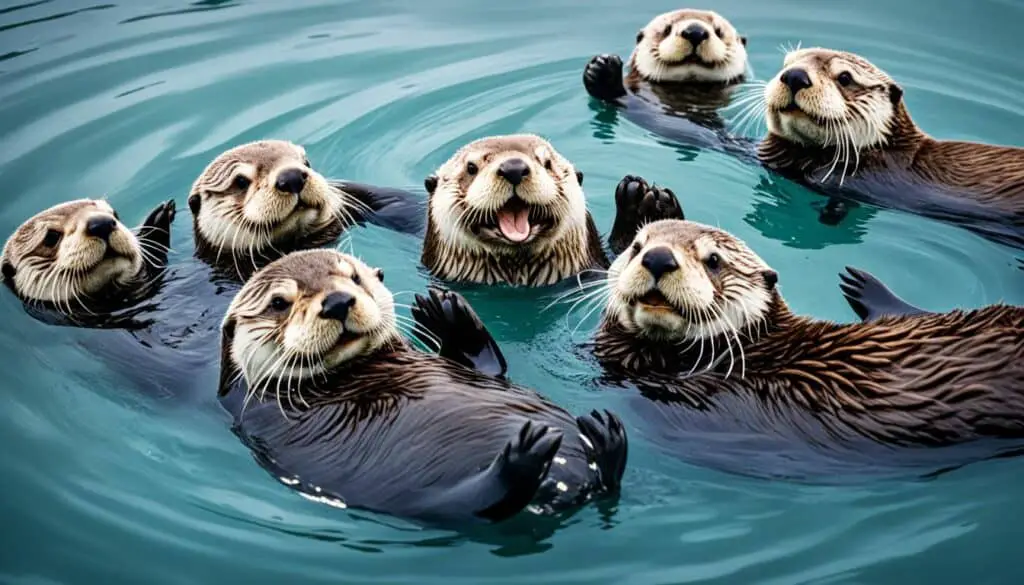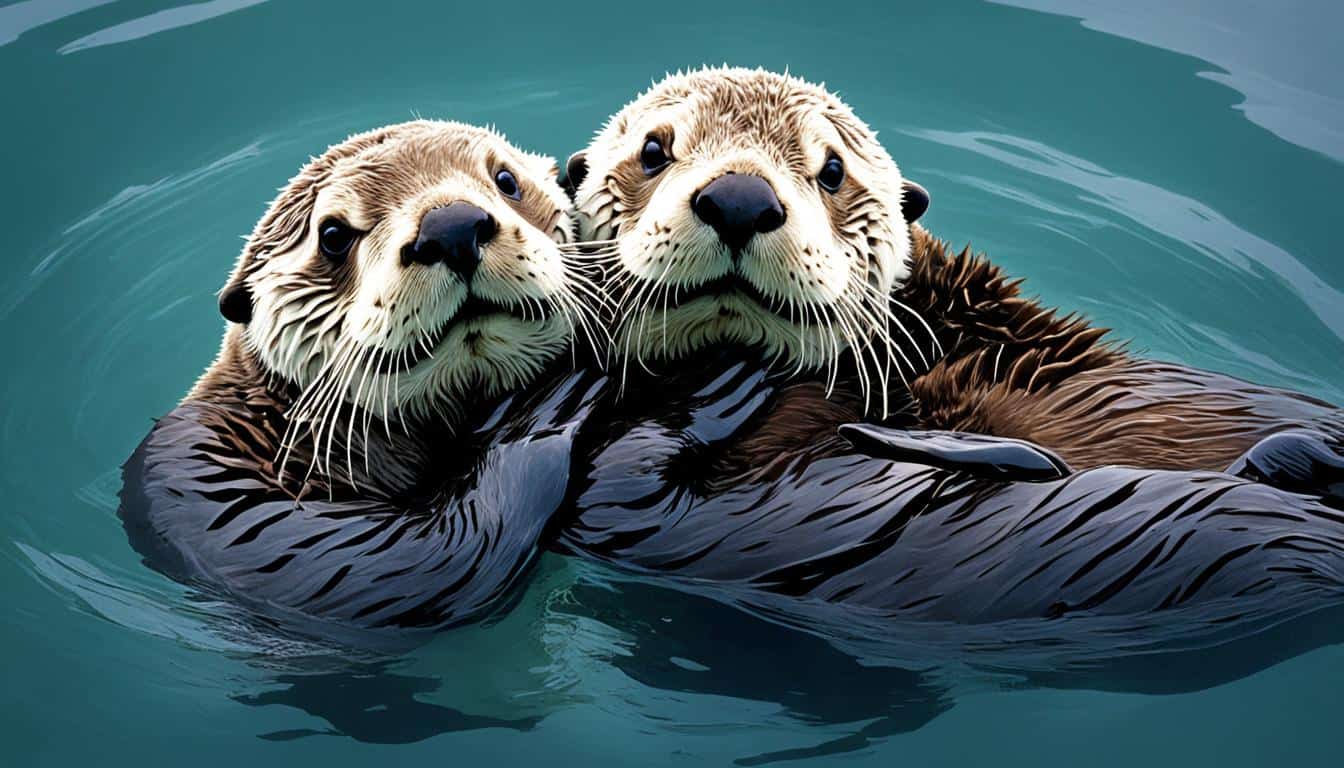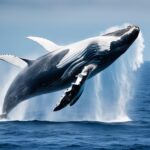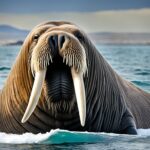Sea otters are not just cute; they have behaviors that capture our hearts. One such behavior is holding hands while they sleep. This act became famous after a touching video from the Vancouver Aquarium in 2007. But why do sea otters hold hands?
This behavior shows how social and unique sea otters are. They don’t have blubber like other marine mammals. Instead, they use their thick fur to stay warm. To avoid getting separated, they form groups called rafts. This shows their need for companionship and safety in the water.
The Heartwarming Behavior of Sea Otters Holding Hands
Sea otters are known for their adorable habit of holding hands while they sleep. This behavior shows their playful side and has a practical reason. By holding paws, they make sure they stay together and don’t get separated in the water.
This act of holding hands is more than just for warmth. It shows their strong social bonds. Watching them cuddle in the water is both cute and heartwarming.
Sea otters show their unique personalities when they hold hands. It’s a sign of how important social connections are to them. They prove that even animals value affection and relationships.
Understanding Sea Otter Behavior and Social Dynamics
Sea otters have a complex social life, especially in how they interact with each other. They often live in big groups called rafts. These groups can have just a few or more than a hundred members. This shows how much they like living together.
When they rest or sleep, sea otters often touch each other. They use kelp to keep themselves close. This helps them stay warm in cold water and protects them from predators. These actions show how important being together is for their health and safety.

Being social is key to sea otters’ survival. Touching each other builds trust and keeps the group strong. Learning about their social life helps us understand their role in the ocean and why they need each other.
Why do sea otters hold hands?
Sea otters hold hands as part of their unique social life. This behavior is key to understanding their social structure and ecology.
The Role of Rafts in Sea Otter Socialization
Rafts are crucial for sea otter social life. These groups help otters rest, groom, and interact safely. Holding paws has several benefits:
- Prevention of Separation: Ocean currents can push otters apart. Holding hands keeps them together.
- Enhanced Grooming: Touch helps with grooming, which is important for their thick fur.
- Reinforcement of Bonds: Being close strengthens group bonds, building a community feeling.
Emotional Connections Among Sea Otters
Sea otters show affection by cuddling and holding paws. This not only shows comfort but also builds a strong support network. These emotional bonds are vital for:
- Providing comfort in tough times.
- Encouraging cooperative behaviors that help them survive.
- Creating stable groups for better health and population stability.
These amazing creatures show how important holding hands is for their social and ecological life. It builds a strong base for their communities and well-being.
Key Sea Otter Facts You Should Know
Sea otters are fascinating creatures with unique physical traits and eating habits. They are not just cute; they are crucial to their ecosystems. Here, you’ll learn about their special adaptations and lifestyle.
Physical Attributes and Adaptations
Sea otters have an amazing layer of fur with up to a million hairs per square inch. This fur keeps them warm in cold water. They don’t have blubber, so their fur is key to staying warm.
Their small ears and body shape help save heat. Their flexible paws are perfect for finding food. These features let them live in different marine places.
Diet and Feeding Habits
Sea otters eat a lot, about 25 percent of their body weight daily. They mainly eat marine animals like clams, crabs, and sea urchins. They use tools, like rocks, to open hard shells.
This smart way of eating makes them important for their ecosystems. They help keep kelp forests healthy.
The Importance of Kelp Forests in Sea Otter Habitat
Kelp forests are key to sea otters’ survival, offering food and shelter. These underwater forests are found in coastal areas and support many marine species. For sea otters, kelp is a safe place to rest and find food. Understanding these ecosystems helps us see how they keep everything in balance.
Sea otters play a big role in their ecosystem by keeping sea urchin numbers in check. If sea urchins get too many, they can destroy kelp forests. But, sea otters eat these urchins, which helps protect the kelp and keeps the ocean healthy. This shows how important sea otters are to their home.
Studies have found a strong link between sea otters and healthy kelp forests. Protecting these forests is crucial for sea otters, especially with threats to their environment. By supporting conservation, we help sea otters and the ocean. Keeping these forests safe means a healthy future for sea otters and our oceans.
FAQ
Why do sea otters hold hands while sleeping?
Sea otters hold hands to prevent drifting apart in open waters. This shows their social nature and keeps them close in their groups.
What is the significance of rafts in sea otter behavior?
Rafts are key for sea otters. They offer chances for socializing and physical contact. This strengthens their group bonds and boosts their safety and happiness.
How do sea otters contribute to their ecosystem?
Sea otters are vital to marine ecosystems. They keep sea urchin numbers in check. Without them, sea urchins could harm kelp forests.
What physical adaptations do sea otters have?
Sea otters have super thick fur for warmth since they don’t have blubber. They also use tools like rocks to open shellfish.
What do sea otters eat?
Sea otters eat marine invertebrates like clams, crabs, and sea urchins. They need to eat about 25 percent of their body weight every day to stay energized.
Why are kelp forests important for sea otters?
Kelp forests are crucial for sea otters. They provide shelter, food, and safety. Having sea otters in these areas helps keep the marine life diverse and balanced.
How do sea otters show emotional connections?
Sea otters show love through cuddling, grooming, and holding hands. These actions build trust and group bonds, which are key to their social life.
Source Links
- https://www.discovermagazine.com/planet-earth/sea-otters-hold-hands-while-sleeping-and-they-even-cuddle
- https://danspetcare.com/otters-hold-hands-while-sleeping-so-they-dont-float-away-from-each-other
- https://timesofindia.indiatimes.com/etimes/trending/sea-otters-hold-hands-while-they-sleep-and-5-other-cute-animal-facts/photostory/107850269.cms







